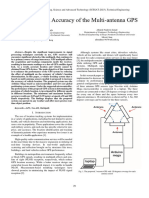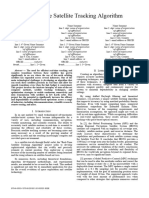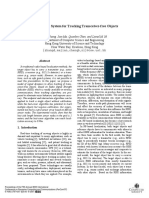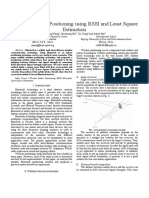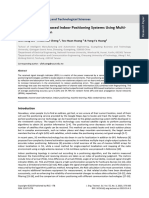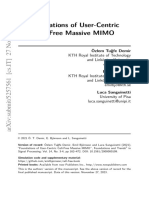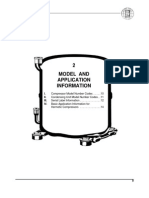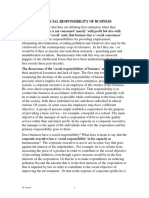Validation of aeronautical fuselage channel model for Iris AirTraffic Management via satellite
Marquez, E.S.; Prieto-Cerdeira, R.; Perez, R.O.; Burzigotti, P. Antennas and Propagation (EUCAP), 2012 6th European Conference on Digital Object Identifier: 10.1109/EuCAP.2012.6206546 Publication Year: 2012 , Page(s): 2440 - 2444 IEEE CONFERENCE PUBLICATIONS
ABSTRACT
The aim of this paper is to validate existing aeronautical fuselage multipath and previous assumptions, based on measurements from an experimental flight campaign. Particularly, the results of the study will be used to consolidate the on-going communication system design activities, in the frame of the European Space Agency (ESA) Iris Programme for Air Traffic Management via Satellite. The data analyses focus on the detection of strong fuselage multipath effects and on the characterization of the channel for the different flight phases. The campaign included several experimental flights from Amsterdam airport towards and around Accra, Ghana and from Amsterdam to Spitsbergen area, close to the North Pole. During the experimental flights, GPS L1 signal data was recorded using the Spirent Record & Playback GSS6400 equipment, as analogy to the L-band channel to be implemented for the operational service. This collected data was processed to characterise fuselage multipath effects during the en-route phase of flight at different elevation/azimuth. Results of carrier-to-multipath (C/M) ratio and fading (C/No) time-series at different satellite elevation angles are presented and compared with existing aeronautical fuselage models. Furthermore, electromagnetic simulations based on Method of Moments have been used to contrast the observations.
Fast and Accurate Cooperative Tracking in Wireless Networks
Sathyan, T.; Hedley, M. Mobile Computing, IEEE Transactions on Volume: PP , Issue: 99 Digital Object Identifier: 10.1109/TMC.2012.151 Publication Year: 2012 , Page(s): 1 IEEE EARLY ACCESS ARTICLES
ABSTRACT
The utility of wireless networks for many applications is increased if the locations of the nodes in the network can be tracked based on the measurements between communicating nodes. Many applications, such as tracking fire fighters in large buildings, require the deployment of mobile ad hoc networks. Real-time tracking in such environments is a challenging task, particularly combined with restrictions on computational and communication resources in mobile devices. In this paper we present a new algorithm using
�the Bayesian framework for cooperative tracking of nodes, which allows accurate tracking over large areas using only a small number of anchor nodes. The proposed algorithm requires lower computational and communication resources than existing algorithms. Simulation results show that the algorithm performs well with the tracking error being close to the posterior Cramer-Rao lower bound that we derive for cooperative tracking. Experimental results for a network deployed in an indoor office environment with external GPS referenced anchor nodes are presented. A computationally simple indoor range error model for measurements at the 5.8 GHz ISM band that yields positioning accuracy close to that obtained when using the actual range error distribution is also presented.
Tightly coupled GPS/INS airborne navigation system
Jamal, S.Z. Aerospace and Electronic Systems Magazine, IEEE Volume: 27 , Issue: 4 Digital Object Identifier: 10.1109/MAES.2012.6203717 Publication Year: 2012 , Page(s): 39 - 42 IEEE JOURNALS & MAGAZINES
ABSTRACT
The developed test bench of tightly coupled GPS/INS integrated navigation system for an airborne vehicle was analyzed herein. From the obtained result, the performance of developed integrated navigation and workflow of the scheme is found correct. Particular attention was focused on the ability of the navigation filter to identify and remove the IMU errors. Along the UAV trajectory the performance of integrated navigation is found to be consistent. Velocity corrections exhibited to be somewhat inefficient, however in the medium accuracy IMU and low-grade GPS, the measurement did not permit the desired level of accuracy. Future work for solving the above-mentioned problems to further improve the performance of integrated navigation is required.
A Fault Location Technique for Two-Terminal Multisection Compound Transmission Lines Using Synchronized Phasor Measurements
Chih-Wen Liu; Tzu-Chiao Lin; Chi-Shan Yu; Jun-Zhe Yang Smart Grid, IEEE Transactions on Volume: 3 , Issue: 1 Digital Object Identifier: 10.1109/TSG.2011.2171198 Publication Year: 2012 , Page(s): 113 - 121
�IEEE JOURNALS & MAGAZINES
ABSTRACT
This paper presents a fault location technique for two-terminal multisection compound transmission lines, which combine overhead lines with underground power cables, using synchronized phasor measurements acquired by global positioning system (GPS) based phasor measurement units (PMUs) or digital relays with embedded PMU or by fault-on relay data synchronization algorithms. The technique is extended from a two-terminal fault location method with synchronized phasor measurements as inputs. A novel fault section selector is proposed to select the fault line section in advance. The proposed technique has the ability to locate a fault no matter where the fault is on overhead line or underground power cable. The adopted technique has a solid theoretical foundation and is direct and simple in terms of computational complexity. Both extensive simulation results and field test results are presented to demonstrate the effectiveness of the proposed scheme. The proposed technique has already been implemented in the Taiwan power system since the year 2008. Up to the present, the proposed technique yields excellent performance in practice.
Crowdsourced Trace Similarity with Smartphones
Zeinalipour-Yazti, D.; Laoudias, C.; Costa, C.; Vlachos, M.; Andreou, M.; Gunopulos, D. Knowledge and Data Engineering, IEEE Transactions on Volume: PP , Issue: 99 Digital Object Identifier: 10.1109/TKDE.2012.55 Publication Year: 2012 , Page(s): 1 IEEE EARLY ACCESS ARTICLES
ABSTRACT
Smartphones are nowadays equipped with a number of sensors, such as WiFi, GPS, accelerometers, etc. This capability allows smartphone users to easily engage in crowdsourced computing services, which contribute to the solution of complex problems in a distributed manner. In this work, we leverage such a computing paradigm to solve efficiently the following problem: comparing a query trace Q against a crowd of traces generated and stored on distributed smartphones. Our proposed framework, coined SmartTrace+, provides an effective solution without disclosing any part of the crowd traces to the query processor. SmartTrace+, relies on an in-situ data storage model and intelligent top-K query processing algorithms that exploit distributed trajectory similarity measures, resilient to spatial and temporal noise, in order to derive the most relevant answers to Q. We evaluate our algorithms on both synthetic and real workloads. We describe our prototype system developed on the Android OS. The solution is deployed over our own SmartLab testbed of 25 smartphones. Our study reveals that computations over
�SmartTrace+ result in substantial energy conservation; in addition, results can be computed faster than competitive approaches.
Electromagnetic geo-referenced footprints for energy harvesting systems
Guenda, L.; Collado, A.; Carvalho, N.B.; Georgiadis, A.; Niotaki, K. Radio and Wireless Symposium (RWS), 2012 IEEE Digital Object Identifier: 10.1109/RWS.2012.6175348 Publication Year: 2012 , Page(s): 339 - 342 IEEE CONFERENCE PUBLICATIONS
ABSTRACT
This paper presents a description of a data-base structure that can be used for electromagnetic energy harvesting information by gather energy footprints and relate them with GPS information. The paper describes the information system architecture that is behind the data-base structure and it is expected that it will become a source of information around the world on energy harvesting. Moreover an energy harvesting probe based on Android devices is also presented.
Lane detection based on a visual-aided multiple sensors platform
Yuwei Chen; Jingbin Liu; Ruotsalainen, L.; Liang Chen; Kroger, T.; Kuusniemi, H.; Ling Pei; Ruizhi Chen; Tenhunen, T.; Yiwu Wang Position Location and Navigation Symposium (PLANS), 2012 IEEE/ION Digital Object Identifier: 10.1109/PLANS.2012.6236951 Publication Year: 2012 , Page(s): 740 - 747 IEEE CONFERENCE PUBLICATIONS
ABSTRACT
Currently, GPS is the dominating technology for commercial car navigation applications, which offers acceptable navigation service for door to door navigation. However, within GPS degraded or denied areas, GPS standalone may not support sufficient accuracy and availability for a satisfactory user experience. Lane detection is an important and fundamental functionality to complete various future intelligent transportation system applications. In this paper, multiple candidate solutions for lane detection are investigated including single frequency precise point positioning (PPP), low-cost gyroscope, and visualaided methods. These methods are compared against a traditional standalone GPS solution. The results of driving tests show that single frequency PPP can improve position accuracy by efficiently mitigating the ionospheric error but still cannot fulfill the lane detection functionality while the gyroscope and visual-aided methods show promising results.
�Perturbation analysis for maritime applications
Marino, Armando; Walker, Nick; Hajnsek, Irena Synthetic Aperture Radar, 2012. EUSAR. 9th European Conference on Publication Year: 2012 , Page(s): 509 - 512 VDE CONFERENCE PUBLICATIONS
ABSTRACT
Target detection of marine features is a major topic for the security and monitoring of coastlines. Synthetic Aperture Radar (SAR) has been shown to be particularly useful because of its all-weather and night capability. In this paper a methodology based on the perturbation analysis developed by the authors is presented. The latter can be applied for detection of ships (non-marine targets) or classification of sea ice. The algorithm can be considered to be a negative filter focused on sea. Consequently, all the features which have a polarimetric behaviour different from the sea are detected and considered as targets. A complete validation with RADARSAT-2 full polarimetric data was performed in Portsmouth, UK. An accurate ground truth carried out during the acquisition, was accompanied, considering AIS GPS location and photographic evidences. Moreover, a map of the buoys helped locating this typology of targets. The results showed impressive accuracy, with detection of all the vessels seen during the ground truth.
Quaternion-based Kalman filtering on INS/GPS
Yang, Yuhong; Zhou, Junchuan; Loffeld, Otmar Information Fusion (FUSION), 2012 15th International Conference on Publication Year: 2012 , Page(s): 511 - 518 IEEE CONFERENCE PUBLICATIONS
ABSTRACT
In this paper, two quaternion-based nonlinear filtering methods are applied on the processing of measurements from the low-cost Micro-electromechanical Systems (MEMS) based Inertial Navigation system (INS) and Global Positioning System (GPS). One approach employs an Extended Kalman filter (EKF) propagating the quaternion vector using conventional vector addition operation. However, due to the fact that the unit sphere defined by the quaternion vector is not an Euclidean vector space, the vector addition and scaling should principally not be directly applied. Therefore, in the second approach, an Unscented Kalman filter (UKF) is used which propagates the quaternion vector based on the quaternion product chain rule, having a natural way of maintaining the normalization constraint. A field experiment based on the train ride is made for the comparison. The objective is to verify whether different handlings of nonlinearity in system models and different ways of propagating quaternion vector over time will practically yield differences in the estimation of attitude and sensor bias errors.
�Antennas for Global Navigation Satellite System (GNSS)
Wang, J.J.H. Proceedings of the IEEE Volume: 100 , Issue: 7 Digital Object Identifier: 10.1109/JPROC.2011.2179630 Publication Year: 2012 , Page(s): 2349 - 2355 IEEE JOURNALS & MAGAZINES
ABSTRACT
Global Navigation Satellite System (GNSS) will in effect be fully deployed and operational in a few years, even with the delays in Galileo as a consequence of European Union's financial difficulties. The vastly broadened GNSS spectra, spread densely across 1146-1616 MHz, versus the narrow Global Positioning System (GPS) L1 and L2 bands, together with a constellation of over 100 Medium Earth Orbit (MEO) and Geostationary Earth Orbit (GEO) satellites versus GPS' 24 MEO satellites, are revolutionizing the design of GNSS receive antennas. For example, a higher elevation cutoff angle will be preferred. As a result, fundamental changes in antenna design, new features and applications, as well as cost structures are ongoing. Existing GNSS receive antenna technologies are reviewed and design challenges are discussed.
GNSS-based curved landing approaches with a virtual receiver
Kube, F.; Schon, S.; Feuerle, T. Position Location and Navigation Symposium (PLANS), 2012 IEEE/ION Digital Object Identifier: 10.1109/PLANS.2012.6236880 Publication Year: 2012 , Page(s): 188 - 196 IEEE CONFERENCE PUBLICATIONS
ABSTRACT
The civil aviation of the future should be ecological, economical, and safe. The citizens in metropolises have on the one hand the need to travel efficiently between airports near the city. On the other hand they, do not want to suffer from noise and emission of airplanes starting and landing at airports close to cities. Consequently, the future airplane should harmonize these needs. In order to fulfill these requirements new concepts for departure and approach procedures are mandatory. Curved approaches are one solution since critical regions can be omitted. These complex maneuvers can only be carried out with the help of satellite navigation systems. One major challenge of curved approaches is the changing obstruction of satellite signals due to shadowing effects by the aircraft itself during curved approaches. Existing GPS landing systems suffer therefore degraded performance (continuity, availability, integrity and accuracy) during curved approaches, especially with higher roll angles and at high and low latitudes. To avoid this problem and to meet the requirements of integrity, accuracy, continuity and availability for future GNSS landing
�systems, the concept of the so called "virtual receiver" has been developed in the framework of the research project "Biirgernahes Flugzeug" (Metropolitan Aircraft). The main idea is to avoid obstruction by combining GNSS observations of few antennae, optimally instaUed on the airplane and computing one common aircraft position solution. This paper presents the mathematical concept of the virtual receiver. The benefits in terms of continuity, precision and reliability are evaluated based on a simulation study and from the analysis of real data from a test flight with the research aircraft D-mUF, a Dornier 128-6 from the Institut of Flight Guidance (TV Braunschweig). It will be shown, that virtual receiver outperforms a single antenna solution concerning the precision (DOP-values are reduced by 30 %) and the reliability (MDBs - re reduced by 10 % on average).









